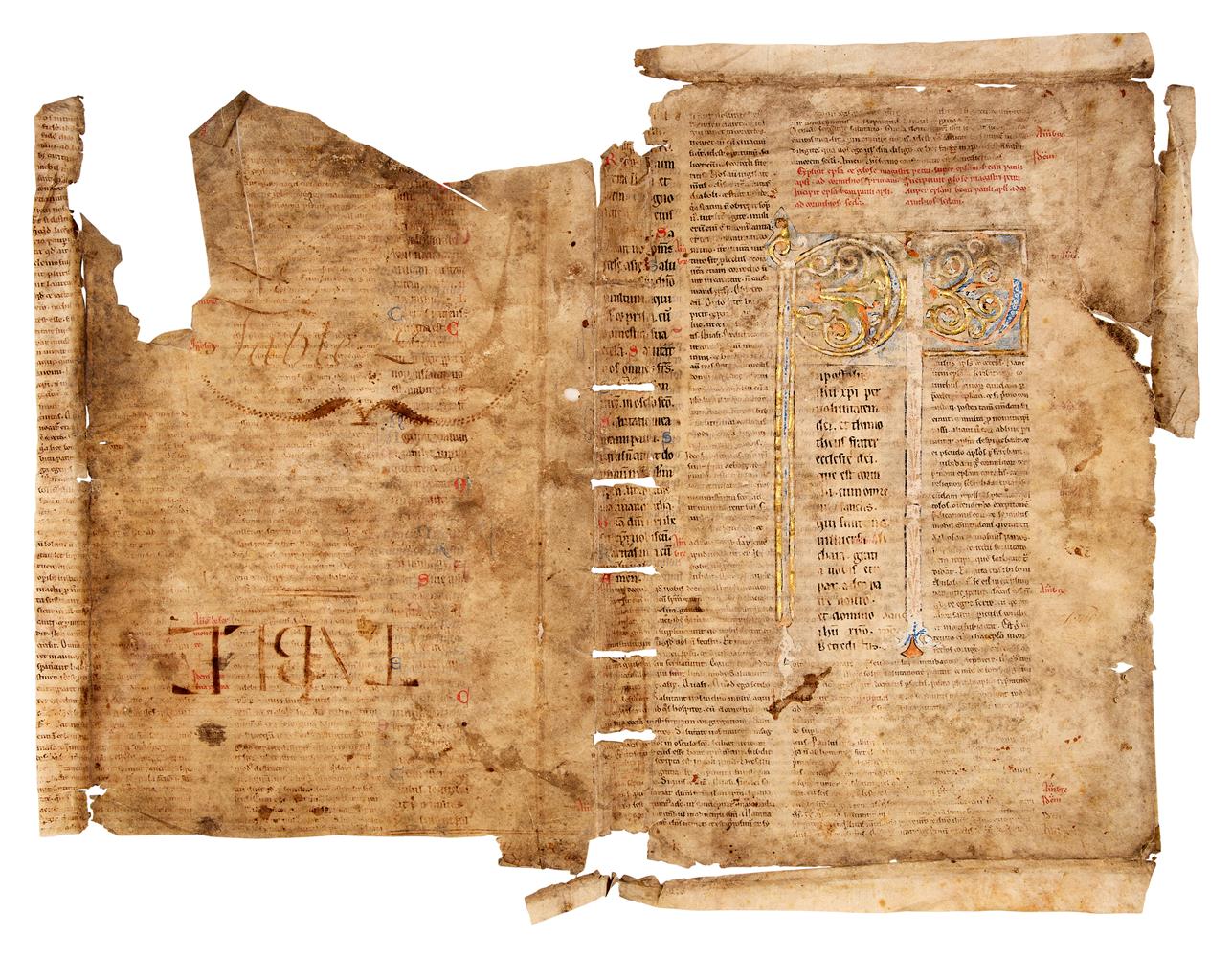THREE LARGE ILLUMINATED INITIALS AND BORDERS on a leaf from a Gospel Lectionary, in Latin, illuminated manuscript on vellum[Bohemia(?), 15th century (first half)] a leaf, c. 385 × 250 mm, ruled in brown ink and written in two columns of 32 lines in fine upright gothic textura script, rubrics in red, the text comprising Luke 17:22 to the end of the chapter, followed by Luke 8:4–15, Matthew 12:29–37, and Luke 21:34, with rubrics indicating that they are the readings for Sunday in Sexagesima (‘Dominica in lx. secundum Lucham’) and the following Wednesday and Friday, each with the standard opening phrase, ‘In illo tempore …’, each with a LARGE ILLUMINATED INITIAL ‘I’ FROM WHICH LUSH FOLIAGE EXTENDS, as well as very straight slim bar borders, the initials themselves each containing an animal, and the foliage extensions with five further animals and birds, with highly burnished gold, one with punched designs; the extreme corners with small punctures and slight rust-stains from being pinned to a board, some cockling especially at the lower edge, adjacent to a water-stain, in a double-sided giltwood frame. PROVENANCEApparently from a volume cut up in the 19th or early 20th century: the extreme corners have small holes, one with rust-marks, where the sheet has been pinned to a mount with thumb-tacks, a practice rarely encountered in later dates.‘The Property of a Swiss Collector’, sold at Christie’s, 23 June 1993, lot 9 (with full-page col. pl.); bought by:The Böhlen Collection, Bern, MS 1400 ILLUMINATIONThis was the finest of four leaves sold at Christie’s, 23 June 1993, lots 8–11, attributed to ‘Southern Germany, Augsburg? ca. 1450’; another leaf (apparently from the same manuscript, although with 34 lines per page) was sold a year later: Christie’s, 29 June 1993, lot 18 (with full-page pl.); the Augsburg attribution was based on a perceived similarity with leaves from the (late 15th-century) Missal of Johannes von Giltlingen, abbot of the monastery of St Ulrich and St Afra in Augsburg, illuminated by Conrad Wagner, but the similarities are rather generic, not specific. The form and palette of the lush foliage, the punch-tooled gold ground, and the very upright textura script, suggest that the leaf may instead be from Bohemia.
THREE LARGE ILLUMINATED INITIALS AND BORDERS on a leaf from a Gospel Lectionary, in Latin, illuminated manuscript on vellum[Bohemia(?), 15th century (first half)] a leaf, c. 385 × 250 mm, ruled in brown ink and written in two columns of 32 lines in fine upright gothic textura script, rubrics in red, the text comprising Luke 17:22 to the end of the chapter, followed by Luke 8:4–15, Matthew 12:29–37, and Luke 21:34, with rubrics indicating that they are the readings for Sunday in Sexagesima (‘Dominica in lx. secundum Lucham’) and the following Wednesday and Friday, each with the standard opening phrase, ‘In illo tempore …’, each with a LARGE ILLUMINATED INITIAL ‘I’ FROM WHICH LUSH FOLIAGE EXTENDS, as well as very straight slim bar borders, the initials themselves each containing an animal, and the foliage extensions with five further animals and birds, with highly burnished gold, one with punched designs; the extreme corners with small punctures and slight rust-stains from being pinned to a board, some cockling especially at the lower edge, adjacent to a water-stain, in a double-sided giltwood frame. PROVENANCEApparently from a volume cut up in the 19th or early 20th century: the extreme corners have small holes, one with rust-marks, where the sheet has been pinned to a mount with thumb-tacks, a practice rarely encountered in later dates.‘The Property of a Swiss Collector’, sold at Christie’s, 23 June 1993, lot 9 (with full-page col. pl.); bought by:The Böhlen Collection, Bern, MS 1400 ILLUMINATIONThis was the finest of four leaves sold at Christie’s, 23 June 1993, lots 8–11, attributed to ‘Southern Germany, Augsburg? ca. 1450’; another leaf (apparently from the same manuscript, although with 34 lines per page) was sold a year later: Christie’s, 29 June 1993, lot 18 (with full-page pl.); the Augsburg attribution was based on a perceived similarity with leaves from the (late 15th-century) Missal of Johannes von Giltlingen, abbot of the monastery of St Ulrich and St Afra in Augsburg, illuminated by Conrad Wagner, but the similarities are rather generic, not specific. The form and palette of the lush foliage, the punch-tooled gold ground, and the very upright textura script, suggest that the leaf may instead be from Bohemia.














Testen Sie LotSearch und seine Premium-Features 7 Tage - ohne Kosten!
Lassen Sie sich automatisch über neue Objekte in kommenden Auktionen benachrichtigen.
Suchauftrag anlegen